GitHub Link: https://gist.github.com/kcb403/43ff09f15f59c622571d287b8c1f22ee
Title
the abyss
Project Abstract
The abyss is a self contained audio visual performance rig. The project makes use of colored reflections from water to evoke feelings serenity and mystery.
Project Description
For our project, the abyss, we wanted to create a performance piece that created an immersive audio visual experience, only using the reflections of water. The concept was mainly inspired by Thomas Wilfred’s Lumia, which to all of our group members, reminded us of the rippling of water. Since water has a connotation of serenity and stillness, we wanted to play with these themes, but also subvert them in an interesting manner.
Perspective and Context
Our project draws many different influences from visual music and abstract art, especially from Thomas Wilfred’s Lumia pieces. For example, our decision to create a self contained rig, was completely inspired by Wilfred’s smaller scale work, such as the Lumia cabinet. Additionally, when watching the documentary and examples of his work, we all noted that the visuals were extremely similar to the reflections in water. This eventually led us to create a rig that used water, and the reflections it made in conjunction with colored light.
Additionally, when brainstorming, we decided to incorporate monks as a sample. This was inspired somewhat by James Whitney’s work, especially Lapis and Arabesque. Both works, which are heavily inspired by the mystique of eastern influences, lead us down the path of mantras and spiritual readings of text. This eventually pointed us in the direction of sampling different rituals and mantras, which evokes feelings of spirituality, serenity and mystique.
Development & Technical Implementation
When developing the piece, we all decided it would be best to create a rig that could easily be controlled throughout the performance. Throughout our ideation process, we iterated several designs of what our rig would look like:

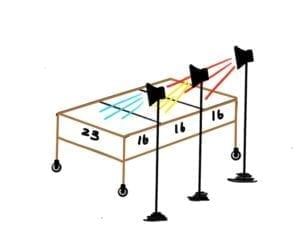
Eventually, we settled on a layered box, with each stack dedicated to a different aspect of the performance. The top layer would act as a holding mechanism for our colored lights, which let in a certain amount of light to the second layer. The second layer, which contained the trays of water, would reflect the colored light, down onto the third and final layer. This last layer contained white sheets of paper, which allowed for the colored reflections to be easily seen. These reflections would then be captured on the webcam that was attached within the bottom layer. If the box was shook, the trays of water would move accordingly, making the reflections move as-well. This would create an interesting ripple effect which could be captured through the webcam.
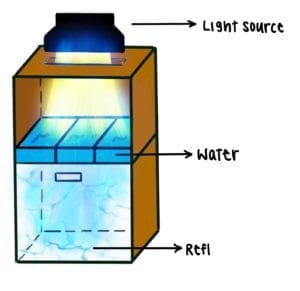
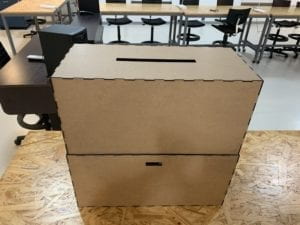
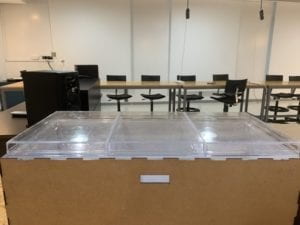
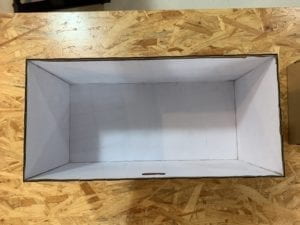
For the patch, Kyle focused on gathering effects befitting for our visuals. These effects would try and evoke feelings of water, but would also still attempt to abstract the visuals. For the audio aspect, I mainly worked on the background audio which played throughout the performance. I used Ableton, a DAW (Digital Audio Workstation), in order to map out the entire 5 minute track, applying different types of effects onto the samples. These included, delay, EQ-ing, reverb, panning of the tracks, and etc.

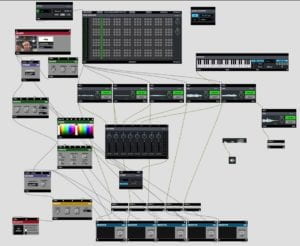
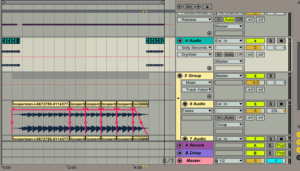
Performance
Up until the actual performance, our group had already practiced a routine to follow. This involved shaking the box rig at certain intervals, and making use of the specific settings for the patch to make visuals that would fit our audio. I would be switching with Celine for controlling the visuals and physically automating the rig, while Kyle controlled the patch and audio. We were all confident that if we followed the routine, we would have a smooth performance.
However, when setting up to present, our entire patch crashed, resetting all of our previous settings and loops. This mishap threw off our entire group, which made us shift from our original routine. Although unexpected disruptions is somewhat of an aspect of live performances, I really would have liked to show our performance at its peak level.
Conclusion
Overall, this project proved to be a difficult yet rewarding task. Not only did all of us push ourselves to play with ideas from abstract film and audio, we even went as far as to creating a self contained reflection rig. I found that working with both my group mates helped especially within the ideation/ brainstorming phase, as everyone had their own input for how to execute the project. In the future, I would like to apply everything I’ve learned from both the first and midterm project to execute a more immersive and stimulating experience in my final.